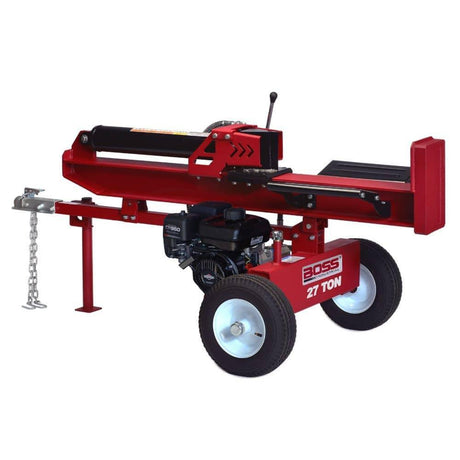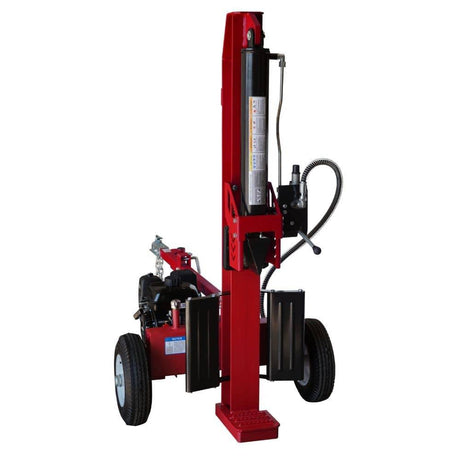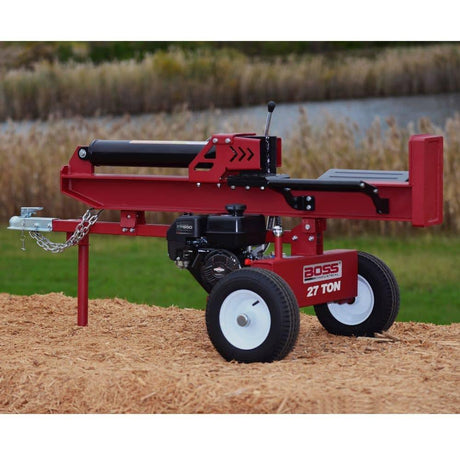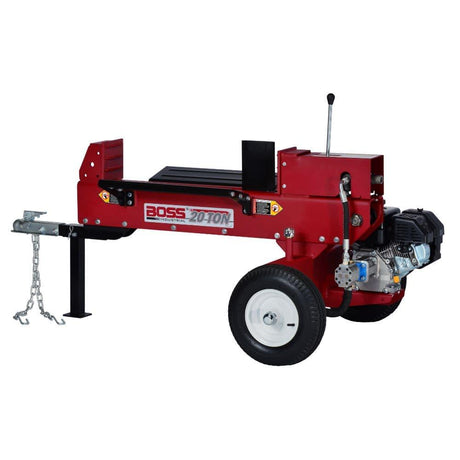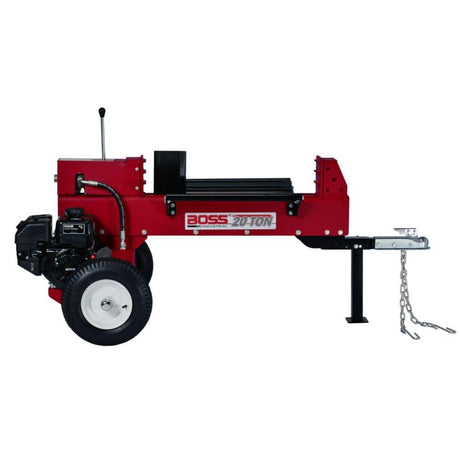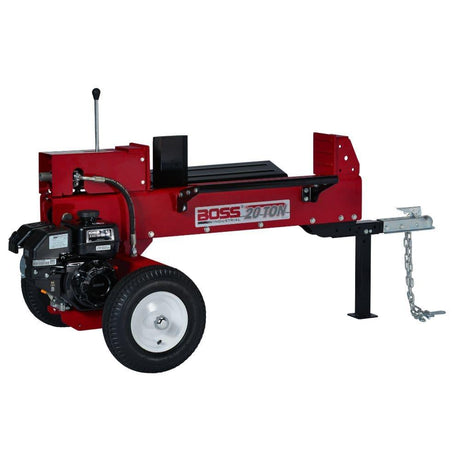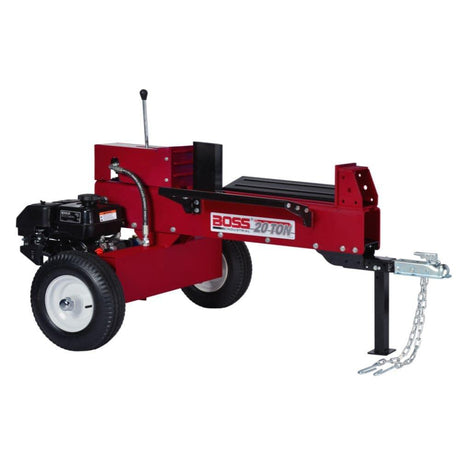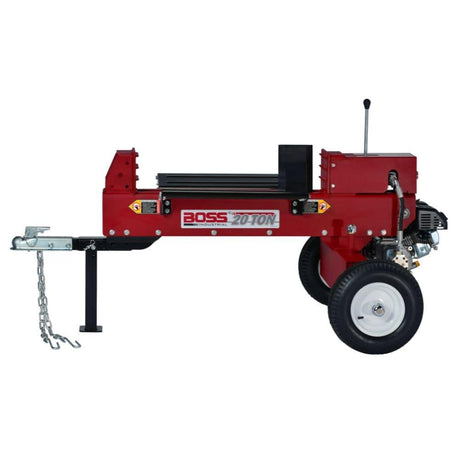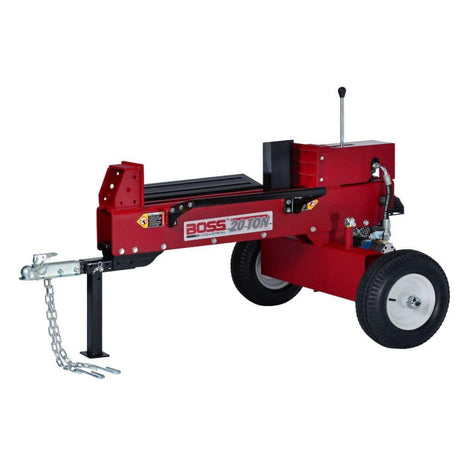Boss Industrial
Boss Industrial WD37T 37 Ton Horizontal/ Vertical Gas Log Splitter
$2,359.00Unit price /UnavailableBoss Industrial
Boss Industrial WD27T 27 Ton Horizontal/ Vertical Gas Log Splitter
$1,599.00Unit price /UnavailableBoss Industrial
Boss Industrial GD20T24 20-Ton Dual Action Gas Log Splitter
$1,899.99Unit price /UnavailableBoss Industrial
Boss Industrial GD16T21 16-Ton Dual Action Gas Log Splitter
$1,669.99Unit price /Unavailable
Shop Towable Log Splitters for Fast, Powerful Wood Splitting
Why Choose a Towable Log Splitter?
If you're regularly splitting firewood on a large property, running a firewood business, or just tired of wrestling with logs far from home, a towable log splitter can be a game changer. Unlike stationary models, these units hook directly to your truck, trailer, or ATV hitch and go wherever the woodpile is.
Whether you're clearing storm debris on acreage or prepping cords for winter, a pull behind log splitter offers the perfect mix of power, mobility, and convenience-especially when you're working off-grid or across multiple job sites.
- Ideal for rural landowners and firewood entrepreneurs
- No need to load logs into the truck-bring the machine to the wood
- Pairs easily with most 2-inch ball hitch setups, making towing simple
If mobility matters to you, this is your workhorse. It's not just a log splitter on wheels-it's a time-saver.
Key Benefits for Homeowners, Landowners, and Professionals
Whether you're heating a cabin or processing logs for clients, tow-behind log splitters bring serious advantages:
- Heavy-duty performance: High-tonnage power for tough, knotty logs
- Highway towing: Many models come with DOT-approved tires, safety chains, and lighting kits
- Multi-vehicle hookup: Compatible with pickup trucks, UTVs, and trailers via standard 2" coupler
- Split on-site: Great for large properties, farms, or remote areas
For homeowners, it's the best log splitter for large properties. For pros, it's a transportable log splitter for jobsites. For everyone, it's a smarter way to split.
How They Work: Gas Power, Hydraulic Force, and Towing Options
Towable log splitters typically use fuel-efficient gas engines paired with heavy-duty hydraulic systems to drive the ram. You'll often find models with a steel frame, log cradle, and auto return valve to speed up cycles.
Here's how it all comes together:
- Engine: Usually 196cc-420cc, with an easy start recoil system
- Hydraulics: Deliver massive pressure for splitting logs up to 35 tons
- Towing: Equipped with 16-inch pneumatic tires, DOT trailer lights, and a trailer jack stand for easy hookup
- Operation: Many offer horizontal/vertical splitting, letting you handle large rounds without lifting
From firewood splitter for acreage to mobile log splitter for farms, these machines are built for work that doesn't wait.
Best-Selling Towable Log Splitters on This Page
Splitter Sizes: From 20-Ton to 35-Ton
Not all jobs need the same muscle. That's why we stock models ranging from 15-ton to 35-ton capacities. Here's a quick breakdown:
- 20-25 Ton: Great for softwoods, moderate-sized rounds, and home use
- 27-30 Ton: Perfect balance for landowners and firewood sellers
- 35 Ton: Built for pros and the biggest hardwood rounds
These towable gas log splitters are more than enough to power through your woodpile fast-especially when paired with features like a log tray or catcher.
Horizontal vs. Vertical Towable Models
Choosing between a horizontal and vertical towable splitter comes down to your log size and physical needs:
- Horizontal Operation: Faster for small to medium logs, with shorter cycle times
- Vertical Mode: Lets you roll big rounds into place-no lifting
Many of our models are horizontal/vertical operation hybrids, giving you the flexibility to switch modes on the fly. It's a must-have for uneven terrain or when you're splitting massive rounds solo.
Trailer Compatibility and Highway-Rated Options
A solid log splitter with trailer kit should do more than just roll around the yard-it should handle the road.
- Highway-ready log splitter models are DOT-compliant and built for hauling at speed
- Road tow log splitters come with road-ready tires, sealed hubs, and lighting kits
- Works with ATVs, trucks, or trailers, depending on your setup
If you're constantly moving between jobsites, don't settle for a garden-variety splitter. Go with one that's built to travel.
2" Coupler, DOT-Approved Tires, and Lighting Features
Every towable unit we feature includes key towing essentials:
- 2-inch ball hitch: Standard fit for pickups, UTVs, and trailers
- DOT-approved trailer tires: 16" pneumatic, rated for off-road and highway use
- Lighting kit: Brake lights, turn signals, and reflectors for legal road use
- Safety chains + trailer jack stand: For secure hauling and easy parking
In short, these are true heavy-duty towing log splitters-not just carts with engines. They're designed for real-world hauling, real work, and serious output.
What to Look for When Buying a Towable Log Splitter
Tonnage and Log Size Capacity
The first thing to dial in is how much force you actually need. Towable log splitters usually range from 20 to 35 tons of splitting force, which covers just about everything from backyard cleanup to full-on firewood production.
Here's a rough guide:
- 20-25 tons: Handles logs up to 24" in diameter. Great for homeowners working with softwood.
- 27-30 tons: A solid middle ground for landowners and firewood sellers dealing with mixed hardwood.
- 35 tons: Built for professionals. Think oversized, knotted, frozen, or stringy rounds.
If you're running a firewood business or live on a rural property with dense trees, a high tonnage capacity will save you both time and back pain. These aren't toys-they're log splitters for acreage and serious work.
Engine Type and Cycle Time
When you're choosing a towable gas log splitter, the engine is everything. It drives the hydraulic system, controls cycle speed, and determines how much downtime you'll face between logs.
Look for these features:
- Fuel-efficient engine: 196cc to 420cc, depending on the model
- Easy start recoil system: No shoulder-ripping starts
- Cycle time: The sweet spot is 11-14 seconds for most work; pros may want faster
A fast firewood production with mobility depends on this combo-gas power + quick cycle + auto return valve = one smooth operator.
Build Quality and Durability for Rough Terrain
Towable doesn't mean gentle. These machines need to hold up on uneven trails, gravel roads, and muddy job sites.
Key things to check:
- Steel frame log splitter construction
- 16-inch pneumatic tires (never solid rubber)
- DOT-certified trailer splitter design: highway legal, safe to tow
- Heavy-duty hydraulic system: Keeps pressure strong under heavy loads
A good rugged design for off-road towing is what separates a real transportable log splitter for pros from a glorified garden tool.
Ease of Use: Setup, Transport, and Operation
You shouldn't need an engineering degree to get to work. The best log splitters with tow hitch are built with real-world usability in mind.
Here's what helps:
- Horizontal/vertical operation: Flip to vertical for huge logs, stay horizontal for speed
- Log cradle or catcher: Keeps wood from falling or rolling off
- Trailer jack stand + safety chain connection: For quick, stable hookup
- Log splitter with ATV hitch or truck hitch: Versatile towing options
When you're moving between properties or jobsites, ease of setup becomes just as important as power.
Towable vs. Non-Towable Log Splitters: Which One Do You Need?
Advantages of Tow-Behind Log Splitters
A tow-behind log splitter really shines when you need to split wood where it falls. No more loading logs into trucks or hauling them across your property. You bring the splitter to the work.
Top advantages:
- Mobility: Easily towed by truck, ATV, or UTV
- Efficiency: Reduce manual handling-split where the trees are
- Speed: Quick setup with trailer hitch, lights, and pneumatic tires
- Power: Most towables come with higher engine output and heavy-duty hydraulic systems
If you're after fast firewood production with mobility, this is your winner. It's the best towable log splitter for the money when you value both performance and convenience.
When a Standalone or Portable Model Might Be Better
Now, not everyone needs a trailer log splitter. If your yard is small or your woodpile never moves, a portable or electric model may make more sense.
Consider a non-towable log splitter if:
- You split wood close to your house and don't need mobility
- You want a quieter, electric log splitter for indoor or garage use
- You're on a tighter budget and don't need highway-rated towing features
It comes down to use case: if you're splitting a cord once a year near your garage, a towable might be overkill. But for rural landowners, pros, and anyone splitting in the field-it's not just worth it, it's essential.
Frequently Asked Questions (FAQs)
What Kind of Vehicle Do I Need to Tow a Log Splitter?
What Kind of Vehicle Do I Need to Tow a Log Splitter?
Most towable log splitters are built with a standard 2-inch ball hitch, which makes them compatible with a wide range of vehicles:
- Pickup trucks (most common option)
- SUVs with a towing package
- ATVs or UTVs for off-road hauling
For off-road use on farms or large properties, a log splitter with ATV hitch is ideal. But if you plan to tow it on public roads, you'll want a vehicle that supports the trailer's weight and includes proper electrical connections for lights and signals. Always check the splitter's GVWR and compare it to your vehicle's towing capacity.
Can I Tow a Log Splitter on the Highway?
Can I Tow a Log Splitter on the Highway?
Yes-as long as it's highway-rated. Look for models listed as DOT-certified trailer splitters or road tow log splitters. These are equipped with:
- DOT-approved tires (usually 16" pneumatic)
- DOT trailer lights (tail lights, turn signals, reflectors)
- Safety chains
- 2" coupler for secure connection
If your model lacks these features, it's not legal-or safe-to take it above neighborhood speeds. For pros or landowners who travel between properties, a highway-ready log splitter is absolutely worth it.
How Much Power Do I Need for Large or Knotty Logs?
How Much Power Do I Need for Large or Knotty Logs?
If you're dealing with hardwoods, twisted grain, or oversized rounds, go for at least 27 tons of splitting force. Here's a quick reference:
- 20-25 ton: Softwoods, clean rounds, residential use
- 27-30 ton: Most hardwoods, occasional gnarly pieces
- 35 ton: Commercial use, giant logs, or frozen rounds
You'll also want a fuel-efficient engine and heavy-duty hydraulic system. The real secret to fast work? A log splitter with auto return valve and a short cycle time. If you want to keep production moving, don't skimp here.
Are Towable Log Splitters Hard to Maintain?
Are Towable Log Splitters Hard to Maintain?
Not at all-if you stay consistent with a few simple tasks:
- Check hydraulic fluid monthly (top off if needed)
- Inspect the engine oil every 10-15 hours of use
- Grease the beam rail and moving parts
- Inspect tires for wear or low pressure (especially road-ready tires)
- Keep the trailer jack stand, lights, and safety chain connection in good condition
Maintenance is minimal, but important-especially before towing. A well-kept log splitter with trailer kit will last for years, even with tough use.
What's the Difference Between Vertical and Horizontal Towable Models?
What's the Difference Between Vertical and Horizontal Towable Models?
It comes down to log size and workflow:
- Horizontal operation: Faster cycle time, ideal for smaller to medium logs. Great if you're lifting manageable rounds onto the beam.
- Vertical operation: Flip the beam upright so you can roll big rounds into place. No lifting required.
Most modern towable wood splitters offer horizontal/vertical operation-meaning you can switch modes as needed. That flexibility is huge, especially if you're tackling different log sizes across multiple jobsites.
So whether you want the convenience of a portable log splitter with hitch or the versatility of vertical mode for large logs, it's all about matching the splitter to your workflow.

